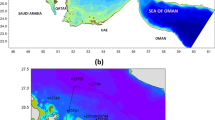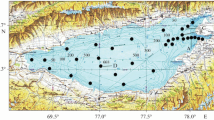Abstract
A hydrographic survey and a 25-hour stationary observation were carried out in the western part of Suo-Nada in the summer of 1998 to elucidate the formation mechanism of the oxygen-deficient water mass. A steep thermocline and halocline separated the upper layer water from the bottom water over the observational area except for near the Kanmon Strait. The bottom water, in comparison with the upper layer water, indicated lower temperature, higher salinity, lower dissolved oxygen, higher turbidity, and higher chlorophyll a. Turbidity in the upper layer water changed with semi-diurnal period while the bottom water turbidity showed a quarter-diurnal variation, though the M2 tidal current prevailed in both waters. From the turbidity distribution and the current variation, it is revealed that the turbidity in the upper layer water is controlled by the advection due to the M2 tidal current. On the other hand, the quarter-diurnal variation in the bottom water turbidity is caused by the resuspension of bottom sediments due to the M2 tidal current. The steep thermocline and halocline were maintained throughout the observation period in spite of the rather strong tidal currents. This implies an active intrusion of the low temperature and high salinity water from the east to the bottom of Suo-Nada. Based on the observational results, a hypothesis on the oxygen-deficient water mass formation was proposed; the periodical turbidity variation in the bottom water quickly modifies the oxygen-rich water in the east to the oxygen-deficient bottom water in Suo-Nada in a course of circulation.
Similar content being viewed by others
References
Hata, Y. (1981): Microbial activities in sedimentation process. Bull. Coast. Oceanogr., 18, 112-122 (in Japanese).
Isobe, A., M. Kamizono and S. Tawara (1993): An oxygen-deficient water mass in the southwestern part of the Suo Sea. Bull. Coast. Oceanogr., 31, 109-119 (in Japanese with English abstract).
Kamizono, M., H. Ikeuchi, H. Tamori and S. Yoshioka (1988): Mean fields of sea condition and water properties in the Suo Sea. Bull. Fukuoka Buzen Fish. Exp. Stn., 1, 137-149 (in Japanese).
Kamizono, M., M. Yoshida and H. Arata (1991): An oxygendeficient water mass in the Suo Sea. Bull. Fukuoka Buzen Fish. Exp. Stn., 4, 185-197 (in Japanese).
Kamizono, M., T. Etoh and H. Arata (1994): Heisei 5-nendo Hin-sanso Suikai Higai Boushi Taisaku Jigyo Houkoku-syo (The report on the protection program against the fisheries damages from the oxygen-deficient water mass in 1993). Fukuoka Fish. and Mar. Tech. Res. Center, Buzen-kai Lab., 19 pp. (in Japanese).
Kamizono, M., A. Isobe, T. Etoh, S. Tawara and Y. Koizumi (1995): Formation mechanisms of oxygen-deficient water mass in the southwestern part of Suo-Nada—Factors affecting temporal fluctuation of oxygen consumption rate. Bull. Coast. Oceanogr., 32, 167-175 (in Japanese with English abstract).
Kamizono, M., T. Etoh and H. Satoh (1996): Oxygen budget of the bottom layer in the southwestern part of Suo-Nada. Umi no Kenkyu, 5, 87-95 (in Japanese with English abstract).
Kawana, K. (1982): Aqua-benthic environment during summer stratification period in the Seto Inland Sea. Bull. Coast. Oceanogr., 20, 53-62 (in Japanese).
Kawana, K. and T. Tanimoto (1981): Temporal variation of resuspended matter for one tidal cycle in the Hiuchi-Nada area. J. Oceanogr. Soc. Japan, 37, 173-178.
Kawana, K. and T. Tanimoto (1984): Turbid bottom water layer and bottom sediment in the Seto Inland Sea. J. Oceanogr. Soc. Japan, 40, 175-183.
Maritime Safety Agency (1997): 1998 Tide Table, Vol. 1. Japan and Its Vicinities, 454 pp. (in Japanese).
Miita, T. and M. Kamizono (1989): Variability of flow field in Suo-Nada on the basis of the historical tidal current data. Bull. Fukuoka Buzen Fish. Exp. Stn., 2, 193-222 (in Japanese).
Oceanographical Division of Kobe Marine Observatory (1985): Marine environment of Suo-nada—Report of special observations in 1982–1983. Bull. Kobe Marine Observatory, 204, 23-37 (in Japanese with English abstract).
Ochi, T. and H. Takeoka (1986): The anoxic water mass in Hiuchi-Nada. Part 1. Distribution of the anoxic water mass. J. Oceanogr. Soc. Japan, 42, 1-11.
Sato, Y. (1979): A laboratory study on dissolved oxygen-consumption of sea mud. Bull. Tokai Reg. Fish. Res. Lab., 98, 55-64 (in Japanese with English abstract).
Takasugi, Y., T. Higo and H. Yasuda (1996a): The role of bottom current in occurrence of oxygen-deficient water mass. Umi no Kenkyu, 5, 1-11 (in Japanese with English abstract).
Takasugi, Y., H. Yasuda, T. Higo and H. Noguchi (1996b): The sea conditions and the profile of the vertical mixing in the western part of the Suo-nada Sea. Report of Chugoku National Industrial Research Institute, 47, 1-14 (in Japanese with English abstract).
Takeoka, H., T. Ochi and K. Takatani (1986): The anoxic water mass in Hiuchi-Nada. Part 2. The heat and oxygen budget model. J. Oceanogr. Soc. Japan, 42, 12-21.
Takeoka, H., O. Matsuda and T. Yamamoto (1993): Processes causing the chlorophyll a maximum in the tidal front in Iyo-Nada, Japan. J. Oceanogr., 49, 57-70.
Tokuda, M. and M. Kamizono (1989): The mass mortality of oyster occurred in the summer of 1988. Bull. Fukuoka Buzen Fish. Exp. Stn., 2, 163-177 (in Japanese).
Uda, M. and N. Watanabe (1933): Hydrographical research on the normal monthly conditions of the Seto-Naikai. Bull. Fish. Exp. Stn., 3, 137-164 (in Japanese with English abstract).
Unoki, S. (1972): Exchange of sea water in the Seto Inland Sea. Bull. Coast. Oceanogr., 9, 5-14 (in Japanese).
Unoki, S. (1993): Engan no Kaiyo Butsuri-gaku. Tokai Univ. Press, Tokyo, 672 pp. (in Japanese).
Yamamoto, T., T. Hashimoto, H. Takeoka, T. Sugiyama and O. Matsuda (2000): Middle layer intrusion as an important factor supporting phytoplankton productivity at a tidal front in Iyo Nada, the Seto Inland Sea, Japan. J. Oceanogr., 56, 131-139.
Yasuda, H., Y. Takasugi and T. Higo (1997): Generation of high turbidity layers in the Seto Inland Sea. J. Coastal Res., 25, 31-40.
Author information
Authors and Affiliations
Rights and permissions
About this article
Cite this article
Senjyu, T., Yasuda, H., Sugihara, S. et al. Current and Turbidity Variations in the Western Part of Suo-Nada, the Seto Inland Sea, Japan: A Hypothesis on the Oxygen-Deficient Water Mass Formation. Journal of Oceanography 57, 15–27 (2001). https://doi.org/10.1023/A:1011166418573
Issue Date:
DOI: https://doi.org/10.1023/A:1011166418573




